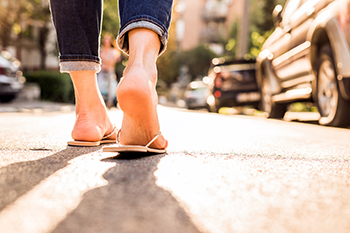
Flip-flops are a popular choice for summer footwear, but they can significantly impact foot biomechanics compared to walking barefoot. Studies comparing traditional flip-flops with more structured versions have highlighted differences in ankle movement and ground reaction forces. Traditional flip-flops often increase dorsiflexion, or the upward bending of the foot at the ankle as you walk. This happens because the toes grip to keep the shoe on. More structured flip-flops reduce ankle eversion, which is the outward rolling of the foot when you stand. This design offers better support and may lower the risk of overuse injuries by minimizing excessive ankle movement and reducing impact at the heel when your foot lands. Even so, the inherent design of flip-flops, which often requires gripping with the toes, can lead to discomfort and long-term foot issues. This gripping action can strain the muscles and tendons, leading to plantar fasciitis or tendonitis, among other problems. While flip-flops provide short-term convenience, they may not be ideal for prolonged use or activities that require a lot of walking. To ensure your footwear supports your foot health effectively or to address foot pain, it is suggested that you schedule an appointment with a podiatrist.
Flip-flops are not always the best choice of footwear. If you have any concerns about your feet or ankles, contact Paul A. Santangelo, DPM from Illinois. Our doctor will assist you with all of your foot and ankle needs.
Flip-Flops and Feet
When the weather starts warming up, people enjoy wearing flip-flops. Flip-flops are comfortable, stylish, and easy to slip on and off; they're perfect for any summer beach goer. However, these shoes can cause harm to the feet.
How Can Flip-Flops Affect Me Long-Term?
- Ankle problems
- Hip problems
- Lower back problems
- Pain in the balls of the feet
- Problems with foot arches
- Changes in the way you walk
Are There Injuries Associated with Flip-Flops?
Yes. Since flip-flops are relatively weak and do not provide the same amount of support as sneakers, people who wear flip-flops regularly are more susceptible to injuries. On top of that, the open nature of the shoe makes your feet more prone to other problems, such as cuts and even infections. Common injuries and ailments include:
- Sprained ankles
- Blisters
- Infections
- Cuts and Scrapes
I like Wearing Flip-Flops. Are There Safe Alternatives?
When buying flip-flops, try to find ones that have sturdy soles and that are made of high-quality materials that will support for your feet. These flip-flops will cost more but will also last longer as a result.
If you have any questions please feel free to contact our offices located in Niles and Rockford, IL . We offer the newest diagnostic and treatment technologies for all your foot and ankle needs.
